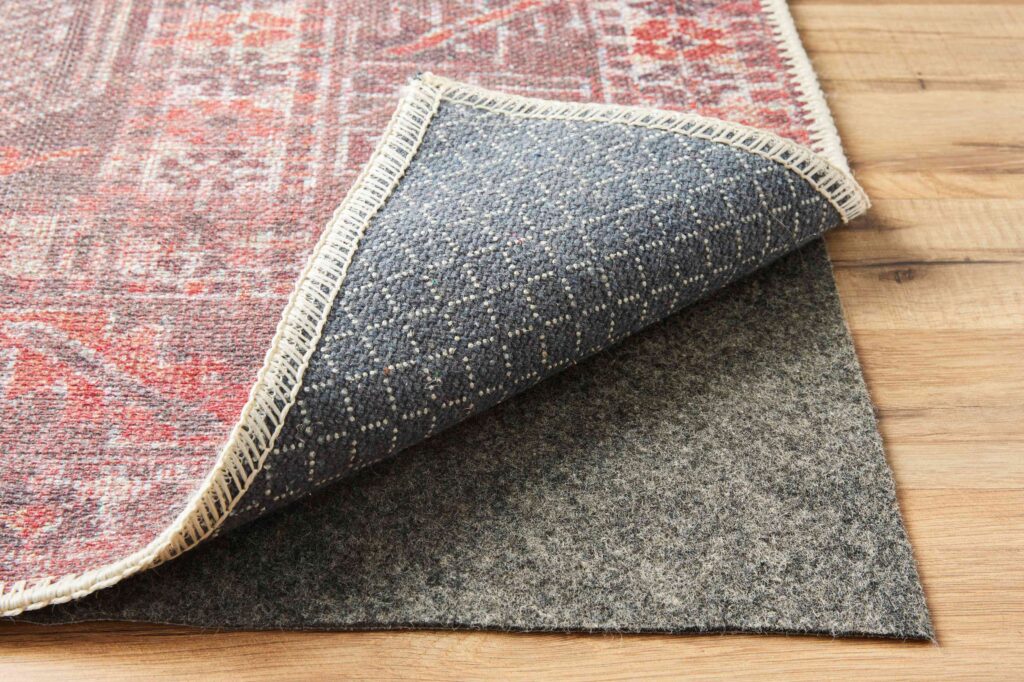
Introduction
Importance of Rug Stability
Rugs are not just decorative pieces but also serve functional purposes such as providing warmth, comfort, and sound absorption. However, a common frustration faced by homeowners is rugs that slip and slide out of place, posing safety hazards and detracting from the overall aesthetics of a room. Ensuring that a rug stays in place is essential for maintaining a safe and visually appealing living environment.
Common Issues with Slipping Rugs
Slipping rugs can lead to accidents such as trips and falls, particularly in high-traffic areas or households with children and pets. Additionally, constantly readjusting and repositioning rugs can be frustrating and time-consuming, detracting from the enjoyment of living spaces. Understanding the root causes of rug slippage is the first step towards implementing effective solutions.
Overview of Solutions
Fortunately, there are various methods and products available to help prevent rugs from slipping and sliding on different types of flooring surfaces. From rug pads to anchoring devices and strategic furniture placement, homeowners have several options to choose from based on their specific needs and preferences.
Rug Pad Selection
Understanding Rug Pads
Rug pads are essential accessories designed to enhance the performance and longevity of rugs while protecting underlying flooring surfaces. They provide cushioning, insulation, and stability, preventing rugs from slipping, bunching, and wrinkling. Understanding the different types of rug pads available and their features is crucial for selecting the right one for your rug and flooring.
Types of Rug Pads
Rug pads come in various materials, including rubber, felt, and foam, each offering unique benefits and characteristics. Rubber pads provide excellent grip and durability, making them ideal for high-traffic areas and heavier rugs. Felt pads offer superior cushioning and protection for delicate flooring surfaces, such as hardwood and laminate. Foam pads provide a balance of grip and cushioning, suitable for rugs in medium-traffic areas.
Choosing the Right Rug Pad
When choosing a rug pad, consider factors such as size, thickness, grip, and compatibility with your flooring type. The pad should be slightly smaller than the rug to allow for a border of exposed flooring around the edges. Opt for a pad with sufficient thickness to provide cushioning and support without raising the rug too high off the floor. Choose a pad with a non-slip grip surface to effectively anchor the rug in place and prevent movement.
Anchoring Methods
Double-Sided Carpet Tape
Double-sided carpet tape is a simple yet effective solution for securing rugs to hard flooring surfaces such as tile, hardwood, or laminate. It features a strong adhesive on both sides that adheres to the rug backing and the floor, preventing shifting and movement. When applying double-sided carpet tape, ensure the surface is clean and dry, and firmly press the tape onto both the rug and the floor for maximum adhesion.
Rug Grippers or Corners
Rug grippers or corners are specially designed devices that anchor rugs in place without damaging the flooring surface. They typically consist of adhesive pads or suction cups that adhere to the underside of the rug and friction pads that grip the floor. Rug grippers are suitable for use on various rug types and can be easily adjusted or repositioned as needed. They are particularly effective in preventing corners and edges from curling or lifting.
Velcro Strips or Pads
Velcro strips or pads provide a secure and customizable anchoring solution for rugs on both hard and carpeted surfaces. They feature hook and loop fasteners that adhere to the rug backing and the floor, creating a strong bond that prevents slipping and sliding. Velcro strips can be trimmed to size and strategically placed along the edges or corners of the rug for optimal stability. They offer versatility in use and can be easily removed or repositioned without leaving residue.
Additional Tips and Tricks
Furniture Placement
Strategic placement of furniture can help anchor rugs in place and prevent slipping and shifting. Heavy furniture pieces such as sofas, coffee tables, and dining tables can act as natural anchors, holding the rug in place and minimizing movement. Position furniture legs on top of the rug to further secure it and prevent curling or lifting of edges and corners.
Regular Maintenance
Regular maintenance of rugs and anchoring devices is essential for ensuring long-term stability and performance. Vacuum rugs regularly to remove dirt, debris, and loose fibers that can affect grip and adhesion. Check and adjust anchoring devices periodically to ensure they remain securely attached and effectively prevent slipping and sliding. Address any signs of wear and tear promptly to maintain the integrity and effectiveness of the anchoring system.
DIY Solutions
For budget-conscious homeowners or those seeking creative alternatives, there are several DIY solutions for making rugs stay in place. Homemade rug grippers can be made using materials such as silicone caulk, hot glue, or rubber shelf liner. Non-slip rug coatings or sprays can be applied to the underside of rugs to enhance grip and adhesion. Creative alternatives such as rug weights, furniture pads, or even adhesive Velcro strips can also be effective in anchoring rugs and preventing movement.
Conclusion
In conclusion, ensuring that a rug stays in place is essential for maintaining a safe, comfortable, and visually appealing living environment. By understanding the importance of rug stability and exploring various solutions such as rug pads, anchoring devices, furniture placement, and DIY alternatives, homeowners can effectively prevent slipping and sliding rugs and enjoy peace of mind knowing that their living spaces are both functional and stylish. Implementing proper rug anchoring techniques not only enhances safety and comfort but also prolongs the life of rugs and protects underlying flooring surfaces from damage.





